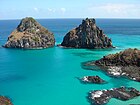Boulder: Difference between revisions
m Reverted edits by Hellothere112200 (talk) (AV) |
m image added |
||
| (35 intermediate revisions by 24 users not shown) | |||
| Line 4: | Line 4: | ||
[[File:Boulder along the chief hike in Stawamus Chief Provincial Park, BC (DSCF7553).jpg|thumb|Boulder in [[British Columbia]], Canada]] |
[[File:Boulder along the chief hike in Stawamus Chief Provincial Park, BC (DSCF7553).jpg|thumb|Boulder in [[British Columbia]], Canada]] |
||
[[File:Kämmenkivi stone in Pisa, Kuopio, Finland.jpg|thumb|''Kämmenkivi'' stone on the Pisa hill in [[Kuopio]], Finland]] |
[[File:Kämmenkivi stone in Pisa, Kuopio, Finland.jpg|thumb|''Kämmenkivi'' stone on the Pisa hill in [[Kuopio]], Finland]] |
||
[[File:Bolders on Mahendra Hills, India.jpg|thumb|2'500 Million years old rocks on a hill in [[Hyderabad]], India.]] |
|||
| ⚫ | In [[geology]], a '''boulder''' (or rarely '''bowlder''')<ref>{{Cite book |title=Webster's New International Dictionary of the English Language |publisher=G. & C. Merriam Company |year=1913 |location=Springfield, Massachusetts}}</ref> is a [[rock (geology)|rock]] fragment with size greater than {{Convert|25.6|cm|in|1|abbr=on}} in diameter.<ref name="Glossary2005">{{cite book | title=Glossary of Geology | publisher=American Geological Institute | editor-last1=Neuendorf | editor-first1=K.K.E. | editor-last2=Mehl | editor-first2=J.P. Jr. | editor-last3=Jackson | editor-first3=J.A. | year=2005 | location=Alexandria, Virginia | page=79 | isbn=978-0922152896| edition=5th }}</ref> Smaller pieces are called [[cobble (geology)|cobbles]] and [[pebble]]s. While a boulder may be small enough to move or roll manually, others are extremely massive.<ref name="Boulder">{{cite dictionary|title=Boulder|url=http://dictionary.reference.com/browse/boulder|dictionary=[[Dictionary.com]]|access-date=24 August 2013}}</ref> In common usage, a boulder is too large for a person to move. Smaller boulders are usually just called [[rock (geology)|rock]]s or stones. |
||
== Etymology == |
|||
| ⚫ | In [[geology]], a '''boulder''' (or rarely '''bowlder''')<ref>{{Cite book |title= |
||
The word ''boulder'' derives from ''boulder stone'', from [[Middle English]] ''bulderston'' or [[Swedish language|Swedish]] ''bullersten''.<ref>[http://dictionary.reference.com/browse/boulder boulder. (n.d.)] Online Etymology Dictionary. Retrieved December 9, 2011, from Dictionary.com website.</ref> |
|||
== About == |
|||
In places covered by [[ice sheet]]s during [[ice age]]s, such as [[Scandinavia]], northern [[North America]], and [[Siberia]], |
In places covered by [[ice sheet]]s during [[ice age]]s, such as [[Scandinavia]], northern [[North America]], and [[Siberia]], [[glacial erratic]]s are common. Erratics are boulders picked up by ice sheets during their advance, and deposited when they melt.<ref name="Boulder" /> These boulders are called "erratic" because they typically are of a different rock type than the [[bedrock]] on which they are deposited. One such boulder is used as the [[pedestal]] of [[the Bronze Horseman]] in [[Saint Petersburg]], Russia. |
||
Some noted [[rock formation]]s involve giant boulders exposed by [[erosion]], such as the [[Karlu Karlu / Devils Marbles Conservation Reserve|Devil's Marbles]] in [[Australia]]'s [[Northern Territory]], the [[Horeke basalts]] in [[New Zealand]], where an entire [[valley]] contains only boulders, and [[The Baths]] on the island of [[Virgin Gorda]] in the [[British Virgin Islands]]. |
Some noted [[rock formation]]s involve giant boulders exposed by [[erosion]], such as the [[Karlu Karlu / Devils Marbles Conservation Reserve|Devil's Marbles]] in [[Australia]]'s [[Northern Territory]], the [[Horeke basalts]] in [[New Zealand]], where an entire [[valley]] contains only boulders, and [[The Baths]] on the island of [[Virgin Gorda]] in the [[British Virgin Islands]]. |
||
Boulder-sized [[Clastic rock|clast]]s are found in some [[sedimentary rock]]s, such as coarse [[conglomerate (geology)|conglomerate]] and [[boulder clay]]. |
Boulder-sized [[Clastic rock|clast]]s are found in some [[sedimentary rock]]s, such as coarse [[conglomerate (geology)|conglomerate]] and [[boulder clay]]. |
||
The climbing of large boulders is called [[bouldering]]. |
|||
==See also== |
==See also== |
||
* [[Bouldering]], [[free climbing]] performed on small rock formations or artificial [[climbing wall]]s |
|||
* [[Moeraki Boulders]] |
|||
* [[Moeraki Boulders]], unusually large spherical boulders found in [[New Zealand]] |
|||
* [[Monolith]] |
|||
* [[Monolith]], a geological feature consisting of a single massive rock |
|||
* [[Udden–Wentworth scale]] |
|||
* [[List of individual rocks]] |
|||
==References== |
==References== |
||
Latest revision as of 11:09, 31 October 2024




In geology, a boulder (or rarely bowlder)[1] is a rock fragment with size greater than 25.6 cm (10.1 in) in diameter.[2] Smaller pieces are called cobbles and pebbles. While a boulder may be small enough to move or roll manually, others are extremely massive.[3] In common usage, a boulder is too large for a person to move. Smaller boulders are usually just called rocks or stones.
Etymology
[edit]The word boulder derives from boulder stone, from Middle English bulderston or Swedish bullersten.[4]
About
[edit]In places covered by ice sheets during ice ages, such as Scandinavia, northern North America, and Siberia, glacial erratics are common. Erratics are boulders picked up by ice sheets during their advance, and deposited when they melt.[3] These boulders are called "erratic" because they typically are of a different rock type than the bedrock on which they are deposited. One such boulder is used as the pedestal of the Bronze Horseman in Saint Petersburg, Russia.
Some noted rock formations involve giant boulders exposed by erosion, such as the Devil's Marbles in Australia's Northern Territory, the Horeke basalts in New Zealand, where an entire valley contains only boulders, and The Baths on the island of Virgin Gorda in the British Virgin Islands.
Boulder-sized clasts are found in some sedimentary rocks, such as coarse conglomerate and boulder clay.
See also
[edit]- Bouldering, free climbing performed on small rock formations or artificial climbing walls
- Moeraki Boulders, unusually large spherical boulders found in New Zealand
- Monolith, a geological feature consisting of a single massive rock
- List of individual rocks
References
[edit]- ^ Webster's New International Dictionary of the English Language. Springfield, Massachusetts: G. & C. Merriam Company. 1913.
- ^ Neuendorf, K.K.E.; Mehl, J.P. Jr.; Jackson, J.A., eds. (2005). Glossary of Geology (5th ed.). Alexandria, Virginia: American Geological Institute. p. 79. ISBN 978-0922152896.
- ^ a b "Boulder". Dictionary.com. Retrieved 24 August 2013.
- ^ boulder. (n.d.) Online Etymology Dictionary. Retrieved December 9, 2011, from Dictionary.com website.
External links
[edit]![]() Media related to Boulders at Wikimedia Commons
Media related to Boulders at Wikimedia Commons


